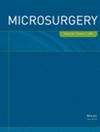Potential of the Thoracoepigastric Vein as a Drainage Vein in Breast Reconstruction With a Free Flap: An Anatomical Study Using Computed Tomography
Abstract
Background
The recipient vessel choice is very important when performing free-flap breast reconstructions. Usually, the concomitant vein of the recipient artery is anastomosed, and mismatches in the diameter are occasionally observed. We consider the thoracoepigastric vein (TEV) as a potential useful recipient vein. The use of the TEV is not a novel technique. It has been used by surgeons for free-flap anastomoses in the axillary region, but usually as an anastomotic site for the second vein. However, anatomical findings such as TEV diameter, its deficiency rate, and influence on mastectomy are not clear. In this study, computed tomography (CT) was performed to evaluate the use of the TEV as a recipient vein for breast reconstruction.
Methods
The medical records of patients who underwent breast reconstruction with free-flap transfer were retrospectively evaluated. In most cases, CT was performed using a tissue expander inserted after mastectomy. The TEV was considered suitable if its diameter on the mastectomy side was >1 mm and the vertical distance from the most distal slice level where the TEV could be seen at the third costal cartilage height of the parasternal region was <50 mm.
Results
Sixty-six sides of 33 patients were evaluated. The mean age of the patients was 49.3 ± 5.1 years. The TEV was used in five flaps. TEV diameters were not significantly different between the left and right sides (1.85 ± 0.53 vs. 1.82 ± 0.6, respectively, p = 0.836). On the mastectomy side, eight (25%) TEVs were injured, but only three (8.6%) were considered unavailable. On the healthy side, 96.4% TEVs were available.
Conclusions
TEVs may be a good choice as vein anastomosis targets for breast reconstruction with a free flap because of their relatively large vessel diameter.
Trial Registration
UMIN-CTR: R000061573

 求助内容:
求助内容: 应助结果提醒方式:
应助结果提醒方式:


